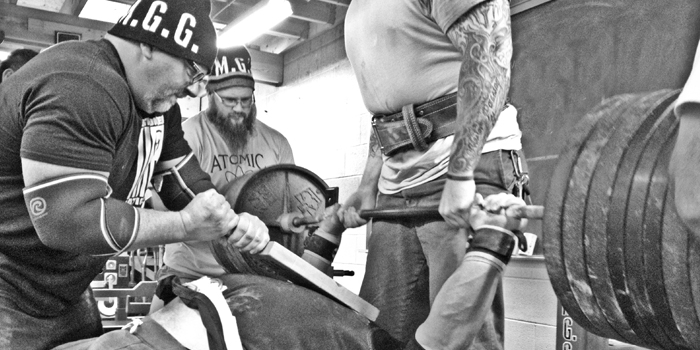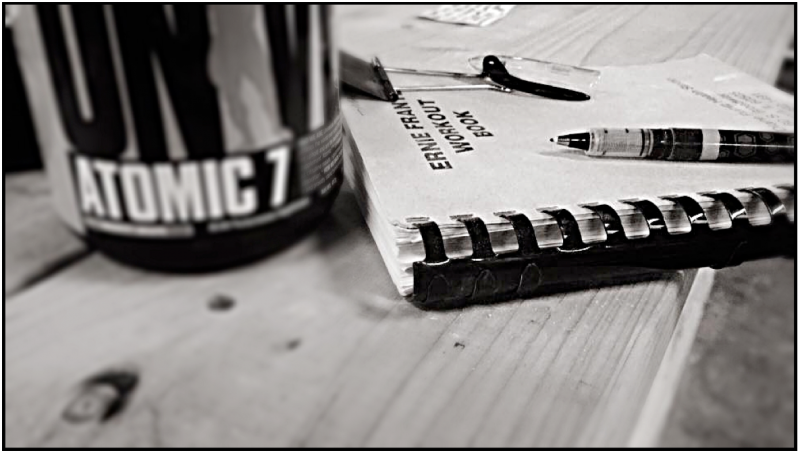
As an eight-track guy living in a download world, I make a point to try and stay as connected to technology as I can.
In the 1980’s I would wait in anticipation for my printing-press-produced issue of Powerlifting USA to arrive so I could be connected to the world of elite powerlifting and be in the know with events from months or weeks prior. I can vividly recall being snail-mailed the VCR tape technology of powerlifting technique, training, and programming in the 1990’s and thinking how much access I now had to the best lifters of the day. Similarly, I can recall in 2000 putting a disc into the CD drive of my computer that would allow me to track—via charts and graphs—my training progress so I could change my program as the sigmoid curve began to show a slowdown during the ascension of my maximum effort lifts.
As technology moves and grows at exponential rates, our access to virtually everything related to powerlifting can be measured in moments, not months. Now is the time to assess that technology. It's also the time to become picky with what type of and when to use technology with regard to our powerlifting success.
Why do we want to do this? We want to do this because not all technology moves our lifting forward. To the contrary, some technology found right in the palm of our hands can be, unknown to us, eroding or retarding the pace of our growth potential.
RECENT: We Are Just Cavemen With Smart Phones
For the past two and a half decades I have logged my training: each rep, every set, the weight, the movement, as well as little notes to myself about how that set, day, or training cycle went. I know through my experiences in the weight room, having trained with hundreds of very good lifters throughout the years, that the majority of serious lifters log their training as they progress through their session. Intrinsically, we know logging the day’s training allows the lifter time between sets to see where they have been and where they are going in that session. This little bit of time between sets is like a mini-recharging time or mental break. It allows for the perspective to call an audible for the day’s training based upon how that session is going.
The logging also allows for the mind to breakdown and process mentally what we just did physically. This internalizing process is a critically important part of keeping one’s mind locked into the training session. When a lifter is really dialed into their training, you can see it, just as you can see when he or she is simply going through the motions on a given day. In my experience, there is a difference between those who work out and those who train. In general, people who work out, do not log their training information. But lifters who train overwhelmingly make it a practice to log their training.
Some months ago I was taking time between sets to write my information in my log book. Next to me someone was doing the same, but logging their workout into an app on their cell phone. Going back to my opening statement, I make a point to try and stay connected to technology to assist in my lifting, so I too downloaded the app and began to take notes of my training. After getting used to the app and logging the information, I used this app’s template to log my training per usual.
Current research data overwhelmingly supports old school note taking vs the use of technology with regard to both retention and attention.
As a life-long lifter and a competitive powerlifter since my first meet in 1989, I, like you, know when I am connected to my training and when I am dialed in to the workout. Likewise, I know when I feel a disconnect with either the training, my lifts, or my body during a session. What I began to experience on a daily basis was a disconnect. I know how important it is to keep copious notes and reflect on those notes, thus it seemed logical that using technology for this seemingly rote task would work to my training advantage.
At first I simply attributed the feeling of disconnectedness with the cell phone app, as it was such a new and unfamiliar way to log my lifts. After all, for the prior two decades, I took pen to paper to note my training. However, over time, I found myself feeling a greater and greater disconnect between my lifts, my body, and my notes. I also noticed that my training sessions were running long, but the work during those sessions was feeling subpar.
In other words, when we train, we feel a connection that—through guys like Lee Haney and others—we know is, “putting your mind into your muscle.“ I recall in the mid-1990’s, someone asked Ernie Frantz to change the music at his gym. Ernie’s response in essence was, "you only notice what music is playing if you are not training hard enough." Watching this one-sentence conversation from the side, I could tell Ernie’s last concern was music in the gym. He was all about that one stretch of time, those precious few hours of that fleeting day when he could train. Point being, Ernie knew what it was like to be dialed in.
Going back to the app and the template: I felt that for whatever reason, logging my training with the smart phone was somehow keeping me from feeling locked in like I normally would. Was the use of technology—be it the light from the screen, being one click away from social media, or just the lack of tactile sensation of the pen digging into the paper of my training log—disconnecting me from my training? And if so, why would so many others in the gym be using their phones to track their training?
Two-Time WPC World Powerlifting Champion and Monster Garage Gym owner Eric Maroscher with his mentor, living legend and the Godfather of Powerlifting, Ernie Frantz.
Interestingly enough, one of the other lifters at the gym, Dr. Rob Keyes (an IPF World Champion and another veteran lifter), is a chemist by trades and keeps his training log information reporter style: on a notepad with a pen. Then when he is home he transfers that hand written information onto his computer so he can plug the numbers into programs to track his lifting progress. In asking Rob about this practice, he stated this feeling of disconnect when not logging via pen and paper and was describing exactly what I was experiencing. What I was discovering after all these years was that the logging of training notes is not as rote as I once thought, but that the practice of keeping my mind focused on my training by writing out my log between sets was the glue that kept the flow going through my training.
In other words, the time I am logging and making notes about numbers and nuances to my lifts, I am also processing or—via the vernacular we used in the psychology department during graduate school—"chunking down” mentally what I had just done physically. So, I started to research why I felt this disconnect by logging my training with a smart phone versus putting ink onto paper as I had done for years. As it turns out, there is actually quite a bit of data explaining, supporting, and affirming these feelings of disconnectedness using the smart phone.
What the research points out is that smart phones and other personal electronic items allow for all of us, with regard to powerlifting, to better able to connect to one another about our lifting, engage in more online research about training, nutrition, programming and the like, as well as take notes on that research. These devices put information like Dave Tate’s Table Talk right there on the screen of your phone. Additionally, as we can all type on the keyboard or peck on the smart phone faster than we can write with pen and paper, taking notes is far more efficient. For these reasons, technology really does enhance our training. More accurate and applicable information can serve to enhance our training as when used correctly and applied properly. These are very powerful tools.
All that said, when we are taking notes in the gym on an iPad or smart phone, we don’t have a need to stop to do research, nor have the need to take non-generative notes, nor do we need to access social media, nor summon any of the other awesome aspects of that smart phone technology. So what is wrong with just taking notes on the phone and why is there that disconnect?
Turns out that there are several reasons why our training suffers when utilizing a smart phone over pen and paper, and those reasons are based on research, not just a gut feeling of disconnect.
Taking notes for accuracy or verbatim in a classroom setting is referred in the academic world as non-generative note-taking. But that is not the sole purpose of the notes we take while training. Our note-taking serves to help us stay connected to the session during that down time and to process mentally what we just did physically. Our training notes are mores generative in nature. How does this happen? Why does taking notes between sets keep our mind sharply focused on our training?
MORE: Here and Now: Mindfulness and Being in the Moment
What the research points out are many areas that are counterintuitive to our thinking regarding technology. Research, specifically that conducted by Pam Mueller and Daniel Oppenheimer from Princeton, concluded via three different experiments that taking notes by hand had a far greater connection to the material, an understanding of the material, and application of the material then via a piece of technology. What Mueller and Oppenheimer postulated is that taking your notes (in this case, writing your training log as you are training) requires a cognitive process that is different than the processing of taking notes via technology. Because of the physical nature and the slower tactile mechanics of writing, the brain fosters far greater comprehension and retention.
To add to this, using technology has an absolutely staggering percentage of distractibility. In their study with students, the unrelated sources available with the laptop/Chromebook (or smart phone in our case) can account for the users disengagement rom the activity at hand to the tune of huge percentages. In the studies, using laptops to take notes versus pen and paper, a whopping 60% were distracted for 50% of the time that they were supposed to be engaged in their actual activity.
Let’s micro-scale this. I think we have all seen this when we drive. The person in front of you at the stop light takes that “one moment” during the red light to check their phone, but that “one moment” to them in smart phone time is vastly different than at the stop light in real time. The result is typically the smart phone driver getting the beep of the horn from the cars behind them as the light has been green for several seconds while they are still transfixed on the information on their phone.
Not dissimilarly, you personally have witnessed this in your gym. You have seen someone during the time between sets either check their phone to log the training or to jump on social media, but the five seconds of downtime actually mutates into several minutes of disconnect. The smart phone user is typically unaware of this extended duration of disconnect. Once they check their social media, texts, and email, they have a 100% disconnect from their next set, when in reality, those moments of downtime meant for logging in the sets and reps should be the mental segue that keeps them engaged for the next set.
There is the old saying that how a span of time feels is related to the situation. The example always given is that one minute of time inside the bathroom door feels very different than one minute of time outside the bathroom door. Watch a person on their cell phone in your gym and you will see the eyes glaze as they mentally go “behind the door” and lose all sense of time, frozen in place staring blankly at the technology in their hand.
This video demonstrates the disconnect I am referring to, as those reading this are the last generation to know a time before the smart phone. Eric Pickersgill talks about how we as users of new technology have to catch up to it and that he calls this shift, “behavior lag.” Through the absolutely amazing yet haunting information and his photos of people with their smart phones removed from their hands, you can see the sheer mental disconnect from the person’s physical surroundings. You can also see how this 110% takes place in gyms all the time. The mind and body connection of the session is gone when this happens Although the lifting continues, the fluidity of the session is now absent. If you really want to know how deep this rabbit hole goes, watch this video:
Mueller’s research was the smoking gun I was looking for to explain my feelings of disconnect. This was critical to me because, as with you, my training is part of the life-blood that flows through me and I want my time in gym to be the most fulfilling. An hour of training is something you can never get back, so you want it to count.
When we train and log our notes, we are talking about generative note-taking, versus non-generative note-taking, which I mentioned earlier. We are taking notes not merely for accuracy to reflect on the numbers but also to document the feel and affect of the training session. In looking at the aforementioned research, I now also understand that the slower nature of the pen to paper lets us mentally process what we have just physically done. Those few moments of downtime allowing us to process mentally what physically just happened and become the connectivity piece that helps us stay dialed in and keeps the mind in the muscle. All these years the tactile process of the pen digging into the paper and the seemingly arduousness of the hand written notes was actually the cognitive lynch-pin to keep the connection between my mind and my training.
Once I had this information, I took the time to email Dr. Mueller and process all that I learned. I was pretty much done with this issue, as I had gone back to my pen and paper training log and like magic, that old feeling was back and my training was as tight as a drum again. Truth be told, I was ready to move on and had logged this little nugget of gold in the files of my mind and shared it with some folks at the Monster Garage Gym who are true students of the sport.
Then I started thinking about Dave and his creed of Live, Learn, and Pass On and the power of sharing these research-based, eureka, ah-ha moments. It got me thinking that when I see a younger lifter who has always trained with the cell phone, they have nothing to compare their training session to. This means they have no baseline knowledge of years and years and years of true connectivity with the pen and paper log to be able to help them differentiate or juxtapose the feelings between the two methods of documentation. Now having trained with both pen and paper as well as the template on the smart phone, I know the difference is stark, the disconnectivity is huge, and the impact on a serious lifter's training is measurable (60% disconnect, 50% of the time). I know that the copious research backs up what as a lifter I was viscerally feeling.
All that said, this is my reason for sharing this information. There are lifters out there who, based on their own set of variables, would not make this connection that I happened onto simply because of the prior years of the old school paper and pen. Further, I feel fortunate to have had lifters before me share information that truly impacted my lifting for the better. I am hoping that this bit of research-based information will help enhance your training. For me the difference in note taking methods, which initially seem so benign, so innocuous, has in actuality been more than just palpable. The difference of going back to the pen and paper has been essential in the connectivity and cohesiveness of my training.
I think in the coming months and years you will hear more about this as further research emerges. As an assistant principal in my “real life,” I know we are having these discussions all the time about technology, as a growing majority of high school and college students use Chromebooks in the classroom. Even so, with the sheer amount of research that is coming out, when it comes to taking notes, the favor lands heavily on the old school pen and paper method. More time is spent on task and there is far superior retention and mental processing.
As a serious lifter, you know that your time in the gym training is a very precious time. It is one of the few times in your day when you and your training partner can be selfishly working toward your own goals. Not realizing the loss of connection between the mind and the body can and will deviate from the efficacy of their training. If you are rolling old school with notebook and pen training logs, stay the course. If you use a smart phone or other technology for your logs, I encourage you to spend the two bucks on a notebook and pen and feel the difference in connectivity that research has already proven for us.
Technology is not a scourge nor an evil. Technology in so many ways is a boon to society, but the trick is and always will be how we use and apply this technology.
Check in and snap that photo with your phone when you get to the gym if you must, then put that technology in your gym bag and leave it there for the duration of your training. In other words, get technologically disconnected in order for you to become authentically, physically and mentally connected.













Excellent article, bravo!